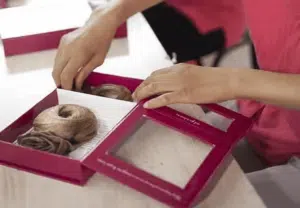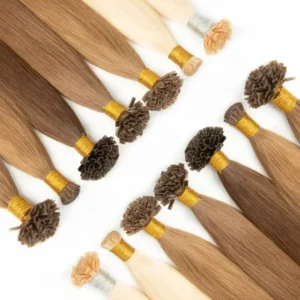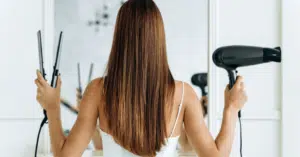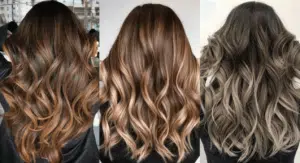Struggling to decide between weft and tape extensions for your salon or brand?
Let’s break it down clearly so you can choose the right one for your business.
Tape extensions are pre-taped wefts that stick to natural hair, while weft extensions are sewn or beaded into the hair. Wefts offer more hold and customization, while tapes are quicker to install and better for fine hair types.

Both options have their advantages—but only if you understand how they work and match them to the right client or business model. Let’s dive into it.
What Are Weft Extensions?
Overwhelmed by the variety of wefts on the market?
Here’s how to simplify your choice and choose the right type.
Weft extensions are strands of hair sewn or bonded into a continuous weft. They can be installed by sewing, micro beading, or gluing, depending on the weft type. They are highly customizable and suitable for long-term wear.

Types of Weft Extensions
- Machine Weft: Heavier and thicker, suitable for dense hair.
- Hand-Tied Weft: Lightweight, natural feel, no cutting needed.
- Genius Weft: Hybrid of hand-tied and machine weft; flat and cuttable.
- Flat Weft: Silicone-based, lies flat against scalp.
| Type | Density | Cuttable | Scalp Feel | Best For |
|---|---|---|---|---|
| Machine Weft | High | Yes | Slightly bulky | Thick/coarse hair |
| Hand-Tied Weft | Low | No | Natural | Fine to medium hair |
| Genius Weft | Medium | Yes | Natural | All hair types |
| Flat Weft | Medium | Yes | Very flat | Fine to thick hair |
Installation Methods for Weft Extensions
- Sew-In: Typically braided base, used for durable installs.
- Beaded Weft: Installed with micro rings or beads.
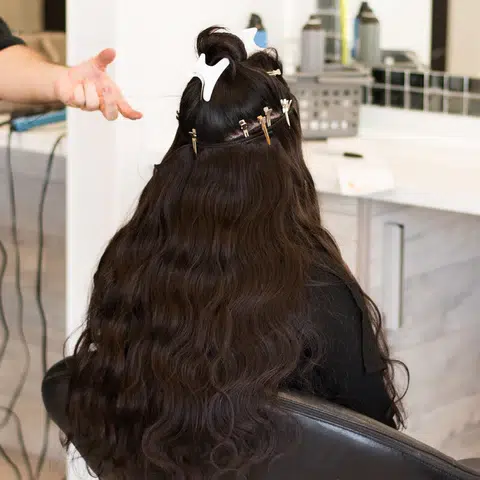
What Are the Cons of Weft Extensions?
- Requires more installation time.
- Some types (like machine weft) are bulky and harder to hide.
- May not be suitable for clients with very fine or weak hair.
- More expensive to install due to labor.
What Are Tape Extensions?
Need a quicker solution for your busy salon schedule?
Tape extensions might be your go-to method.
Tape extensions are pre-taped hair strips with medical-grade adhesive. They are installed by sandwiching a thin slice of the client’s natural hair between two tape wefts. Best for fast, clean installs.

Types of Tape Extensions
- Classical Tape-Ins: Sandwich install, standard PU tape.
- Invisible / Injection Tape-Ins: PU base with hair injected for natural invisible look.
- Micro Tape-Ins: Smaller width, great for temples and hairline.
| Type | Visibility | Flexibility | Best For |
|---|---|---|---|
| Classical Tape-Ins | Medium | Moderate | Medium to thick hair |
| Invisible Injection Tape | Low | High | Fine or light hair |
| Micro Tape-Ins | Very Low | High | Hairline, fine areas |
Installation Process
- Clarify hair – remove all oils and residues.
- Section cleanly and evenly.
- Sandwich natural hair between two tape pieces.
- Press firmly and seal with a flat iron if required.
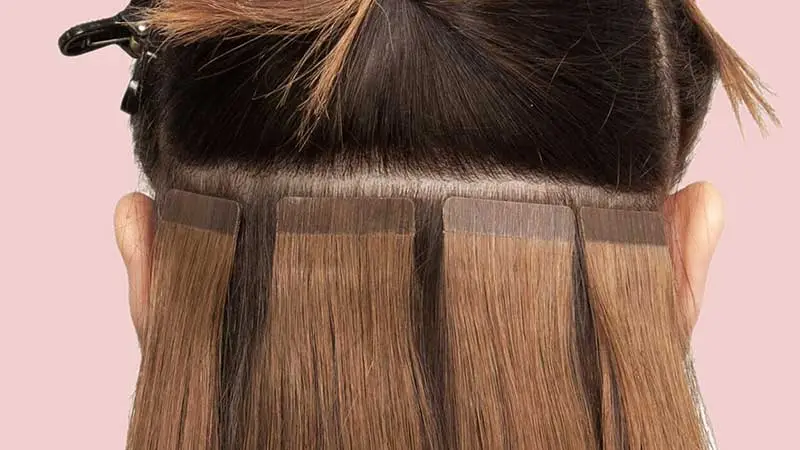
What Are the Cons of Tape Extensions?
- Tape can slip if prep isn’t perfect.
- Clients must avoid oil-based products near the root.
- May require more frequent repositioning (every 6–8 weeks).
- Not great for heavy-volume looks.
What’s the Difference Between Weft and Tape Extensions?
Clients confused between tape and weft? Help them choose confidently.
The key differences lie in the installation method, longevity, styling flexibility, and how much volume you want to achieve.
Installation Method
- Weft: Sewn or beaded into the hair.
- Tape: Sandwiched and pressed in with adhesive.
Longevity
- Weft: 6–10 weeks before move-up, depending on method.
- Tape: 6–8 weeks, usually requires more frequent repositioning.
Volume & Density
- Weft: Offers thicker, fuller installs.
- Tape: Best for lightweight and discreet installs.
Maintenance
- Weft: More durable, less affected by product use.
- Tape: Needs clean hair care routine and careful removal.
| Feature | Weft Extensions | Tape Extensions |
|---|---|---|
| Application Time | 1.5–3 hours | 45–60 minutes |
| Styling Versatility | High | Moderate |
| Best For | Volume, Long-Term Wear | Quick Installs, Thin Hair |

Industry Trends
Looking to stay ahead of what salons are offering?
The market tells a clear story of growth—but it depends on your salon model.
Weft Extensions Are Dominating Luxury Salons
Premium clients prefer hand-tied and genius wefts for long-term use and natural feel. These are now standard in high-end services.
Tape-Ins Still Reign in Fast-Paced Studios
Tape extensions are ideal for salons with high turnover or quick install services. They dominate in mid-market chains and online beauty stores.
Hybrid Techniques on the Rise
More stylists now combine wefts and tapes to customize volume and invisibility, especially for bridal or influencer clients.
Global Supply Shift
Salons are moving away from distributors and sourcing direct from factories like Hibiscus Hair for consistency, cost control, and better quality.
My Opinion
As someone who’s been in the hair business for over 15 years, here’s how I see it:
If your clients are seeking luxury, go with wefts—especially hand-tied or genius styles. They give a refined, seamless finish and last longer.
If speed and flexibility matter more, tape extensions are a solid go-to, especially invisible tape for finer hair.
But no matter which you choose, sourcing full cuticle, ethically collected hair makes all the difference. It’s not just about attachment—it’s about longevity, softness, and how your brand is remembered.

FAQ
Q: Which lasts longer—tape or weft?
A: Weft extensions typically last longer between installs. With proper care, they can also be reused more times.
Q: Can I sleep with these extensions?
A: Yes. Both can be worn while sleeping, but silk pillowcases and loose braids help reduce tangling.
Q: Are tape extensions damaging?
A: Only if installed or removed improperly. Proper sectioning, clarifying shampoo, and gentle removal are key.
Q: How do I choose between hand-tied and genius weft?
A: Hand-tied is great for lightweight, seamless installs. Genius weft offers flexibility because it can be cut.
Q: How many packs do I need for a full head?
A: Typically, 150g–200g is enough. For wefts, this could be 2–3 bundles; for tape, 40–60 pieces depending on volume.
Conclusion
Both weft and tape extensions serve a purpose. Your choice depends on the client, the look, and the service style of your salon.
Hibiscus Hair Manufacturer has been dedicated to producing high-quality weft and tape in hair extensions for 25 years and is a recognized leader in the industry. If you are interested in finding a reliable hair extensions supplier and wholesale for your brand, please visit our website for more information:
HAIR WEFT
HAIR WEFT

